Comparative Quality Control of Titanium Alloy Ti–6Al–4V, 17–4 PH Stainless Steel, and Aluminum Alloy 4047 Either Manufactured or Repaired by Laser Engineered Net Shaping (LENS)
Abstract
1. Introduction
2. Materials and Methods
2.1. 17–4 PH Stainless Steel Rod
2.2. A Fitting Printed of Ti-6Al-4V Alloy
2.3. Repair of a Housing Made of Cast AA3xx Aluminum with Aluminum 4047
2.4. Characterization of the LENS Deposited Materials
3. Results
3.1. 17-4 PH Stainless Steel Rod
3.2. Ti-6Al-4V Fitting
3.3. Al 4047 Housing Deposited from Scratch
4. Discussion
5. Conclusions
- Anisotropic geometrical distortion and overbuild at top edges were observed. These should already be accounted for in the design model, whenever possible.
- In all three materials, microstructures typical of rapid solidification were observed, along with high density, chemical composition, and hardness comparable to those of the counterpart wrought alloys (even in hard condition).
- The detected defects included partially melted and unmelted powder particles, porosity, and interlayer lack of fusion, in particularly at the interface between the substrate plate and the build.
- The sphericity values obtained from μ-CT analysis supported the metallographic and μ-CT images well.
- The standard deviations in hardness values were considerably larger than those in wrought alloys in general, and in polished samples in particular.
- There was a fairly good match between the density values measured by μ-CT and those measured by the Archimedes method; there was also good correlation between the types of defects detected by both techniques.
- For both the Ti-6Al-4V fitting and the Al 4047 housing, reducing the voxel size in μ-CT by a factor of ca. 2–3 allowed detection of pores with volumes smaller by a factor of ca. 10–20. This should be taken into consideration when trying to match porosity analysis based on metallurgical cross-sections to those based on μ-CT. For the best, most representative μ-CT analysis, detaching the build from the substrate plate before analysis is carried out is recommended.
- A novel, non-standard optical gaging procedure for measurement of surface roughness was proposed, using a commercial video and multisensory measurement system with a large measurement range. A fairly good match with values obtained from white light interferometry is shown.
- The surface roughness of the inner walls of bores was particularly poor.
- Surface roughness, density of partially melted powder particles, and the content of bulk defects increased slightly from 17-4 PH stainless steel to Ti-6Al-4V, but then significantly increased in Al 4047.
- The attempt to repair a housing made of cast AA3xx aluminum with Al 4047 failed due to considerable overbuilding and misalignment.
- Parts manufactured by LENS for aerospace applications must undergo surface finishing prior to use. Appropriate tolerances and access to surfaces for complementary surface finishing should already be taken into account in the design stages.
Supplementary Materials
Author Contributions
Funding
Acknowledgments
Conflicts of Interest
References
- Herzog, D.; Seyda, V.; Wycisk, E.; Emmelmann, C. Additive manufacturing of metals. Acta Mater. 2016, 117, 371–392. [Google Scholar] [CrossRef]
- Lynos, B. Additive manufacturing in aerospace: Examples and research outlook. Bridge 2012, 42, 13–19. [Google Scholar]
- Najmon, J.C.; Raeisi, S.; Tovar, A. Review of additive manufacturing technologies and applications in the aerospace industry. In Additive Manufacturing for the Aerospace Industry; Froes, F., Boyer, R., Eds.; Elsevier: Amsterdam, The Netherlands, 2019; Chapter 2; pp. 7–31. [Google Scholar]
- Thompson, S.M.; Bian, L.; Shamsaei, N.; Yadollahi, A. An overview of Direct Laser Deposition for additive manufacturing; Part I: Transport phenomena, modeling and diagnostics. Addit. Manuf. 2015, 8, 36–62. [Google Scholar] [CrossRef]
- Saboori, A.; Aversa, A.; Marchese, G.; Biamino, S.; Lombardi, M.; Fino, P. Application of directed energy deposition-based additive manufacturing in repair. Appl. Sci. 2019, 9, 3316. [Google Scholar] [CrossRef]
- Yusuf, S.M.; Cutler, S.; Gao, N. Review: The impact of metal additive manufacturing on the aerospace industry. Metals 2019, 9, 1286. [Google Scholar] [CrossRef]
- Wilson, J.M.; Piya, C.; Shin, Y.C.; Zhao, F.; Ramani, K. Remanufacturing of turbine blades by laser direct deposition with its energy and environmental impact analysis. J. Clean. Prod. 2014, 80, 170–178. [Google Scholar] [CrossRef]
- Mudge, R.P.; Wald, N.R. Laser engineered net shaping advances additive manufacturing and repair. Weld. J. 2007, 86, 44–48. [Google Scholar]
- Zhai, Y.; Galarraga, H.; Lados, D.A. Microstructure, static properties, and fatigue crack growth mechanisms in Ti-6Al-4V fabricated by additive manufacturing: LENS and EBM. Eng. Fail. Anal. 2016, 69, 3–14. [Google Scholar] [CrossRef]
- Hrabe, N.; Quinn, T. Effects of processing on microstructure and mechanical properties of a titanium alloy (Ti-6Al-4V) fabricated using electron beam melting (EBM), part 1: Distance from build plate and part size. Mater. Sci. Eng. A 2013, 573, 264–270. [Google Scholar] [CrossRef]
- Zheng, B.; Zhou, Y.; Smugeresky, J.E.; Schoenung, J.M.; Lavernia, E.J. Thermal behavior and microstructure evolution during laser deposition with laser-engineered net shaping: Part II. Experimental investigation and discussion. Metall. Mater. Trans. A 2008, 39, 2237–2245. [Google Scholar] [CrossRef]
- Tepylo, N.; Huang, X.; Patnaik, P.C. Laser-Based additive manufacturing technologies for aerospace applications. Adv. Eng. Mater. 2019, 21, 1900617. [Google Scholar] [CrossRef]
- Martin, J.H.; Yahata, B.D.; Hundley, J.M.; Mayer, J.A.; Schaedler, T.A.; Pollock, T.M. 3D printing of high-strength aluminium alloys. Nature 2017, 549, 365–369. [Google Scholar] [CrossRef] [PubMed]
- DebRoy, T.; Wei, H.L.; Zuback, J.S.; Mukherjee, T.; Elmer, J.W.; Milewski, J.O.; Beese, A.M.; Wilson-Heid, A.; De, A.; Zhang, W. Additive manufacturing of metallic components—Process, structure and properties. Prog. Mater. Sci. 2018, 92, 112–224. [Google Scholar] [CrossRef]
- King, W.E.; Barth, H.D.; Castillo, V.M.; Gallegos, G.F.; Gibbs, J.W.; Hahn, D.E.; Kamath, C.; Rubenchik, A.M. Observation of keyhole-mode laser melting in laser powder-bed fusion additive manufacturing. J. Mater. Proc. Technol. 2014, 214, 2915–2925. [Google Scholar] [CrossRef]
- Zhang, J.; Song, B.; Wei, Q.; Bourell, D.; Shi, Y. A review of selective laser melting of aluminum alloys: Processing, microstructure, property and developing trends. J. Mater. Sci. Technol. 2019, 35, 270–284. [Google Scholar] [CrossRef]
- Ding, Y.; Muñiz-Lerma, J.A.; Trask, M.; Chou, S.; Walker, A.; Brochu, M. Microstructure and mechanical property considerations in additive manufacturing of aluminum alloys. MRS Bull. 2016, 41, 745–751. [Google Scholar] [CrossRef]
- Susan, D.F.; Puskar, J.D.; Brooks, J.A.; Robino, C.V. Quantitative characterization of porosity in stainless steel LENS powders and deposits. Mater. Charact. 2006, 57, 36–43. [Google Scholar] [CrossRef]
- Ahsan, M.N.; Bradley, R.; Pinkerton, A.J. Microcomputed tomography analysis of intralayer porosity generation in laser direct metal deposition and its causes. J. Laser Appl. 2011, 23, 022009. [Google Scholar] [CrossRef]
- Masuo, H.; Tanaka, Y.; Morokoshi, S.; Yagura, H.; Uchida, T.; Yamamoto, Y.; Murakami, Y. Effects of defects, surface roughness and HIP on fatigue strength of Ti-6Al-4V manufactured by additive manufacturing. Procedia Struct. Integrity 2017, 7, 19–26. [Google Scholar] [CrossRef]
- Rafi, H.K.; Karthik, N.V.; Gong, H.; Starr, T.L.; Stucker, B.E. Microstructures and mechanical properties of Ti6Al4V parts fabricated by selective laser melting and electron beam melting. J. Mater. Eng. Perform. 2013, 22, 3872–3883. [Google Scholar] [CrossRef]
- Carroll, B.E.; Palmer, T.A.; Beese, A.M. Anisotropic tensile behavior of Ti-6Al-4V components fabricated with directed energy deposition additive manufacturing. Acta Mater. 2015, 87, 309–320. [Google Scholar] [CrossRef]
- Sandgren, H.R.; Zhai, Y.; Lados, D.A.; Shade, P.A.; Schuren, J.C.; Groeber, M.A.; Kenesei, P.; Gavras, A.G. Characterization of fatigue crack growth behavior in LENS fabricated Ti-6Al-4V using high-energy synchrotron x-ray microtomography. Addit. Manuf. 2016, 12, 132–141. [Google Scholar] [CrossRef]
- Mohseni, H.; Nandwana, P.; Tsoi, A.; Banerjee, R.; Scharf, T.W. In situ nitrided titanium alloys: Microstructural evolution during solidification and wear. Acta Mater. 2015, 83, 61–74. [Google Scholar] [CrossRef]
- Hedges, M.; Calder, N. Near net shape rapid manufacture and repair by LENS®. Rapid Prototyp. 2006, 12, 1–13. [Google Scholar]
- Ferguson, J.B.; Schultz, B.F.; Moghadam, A.D.; Rohatgi, P.K. Semi-Empirical model of deposit size and porosity in 420 stainless steel and 4140 steel using laser engineered net shaping. J. Manuf. Process. 2015, 19, 163–170. [Google Scholar] [CrossRef]
- Yang, N.; Yee, J.; Zheng, B.; Gaiser, K.; Reynolds, T.; Clemon, L.; Lu, W.Y.; Schoenung, J.M.; Lavernia, E.J. Process-Structure-Property relationships for 316L stainless steel fabricated by additive manufacturing and its implication for component engineering. J. Therm. Spray Technol. 2017, 26, 610–626. [Google Scholar] [CrossRef]
- Ziętala, M.; Durejko, T.; Polański, M.; Kunce, I.; Płociński, T.; Zieliński, W.; Łazińska, M.; Stępniowski, W.; Czujko, T.; Kurzydłowski, K.J.; et al. The microstructure, mechanical properties and corrosion resistance of 316L stainless steel fabricated using laser engineered net shaping. Mater. Sci. Eng. A 2016, 677, 1–10. [Google Scholar] [CrossRef]
- Wang, L.; Felicelli, S.; Gooroochurn, Y.; Wang, P.T.; Horstemeyer, M.F. Optimization of the LENS® process for steady molten pool size. Mater. Sci. Eng. A 2008, 474, 148–156. [Google Scholar] [CrossRef]
- Hofmeister, W.; Griffith, M. Solidification in direct metal deposition by LENS processing. JOM 2001, 53, 30–34. [Google Scholar] [CrossRef]
- Singh, A. Additive Manufacturing of Al 4047 and Al 7050 Alloys Using Direct Laser Metal Deposition Process. Ph.D. Thesis, Wayne State University, Detroit, MI, USA, January 2017. [Google Scholar]
- España, F.A.; Balla, V.K.; Bandyopadhyay, A. Laser processing of bulk Al-12Si alloy: Influence of microstructure on thermal properties. Phil. Mag. 2011, 91, 574–588. [Google Scholar] [CrossRef]
- Ramesh, N. Structure-Process-Property Relationships for LENS® and SLM Processed AlSi10Mg Alloys and the Effect of Heat Treatment. Master’s Thesis, University of California, Irvine, CA, USA, 2018. [Google Scholar]
- Zheng, B.; Li, Y.; Smugeresky, J.E.; Zhou, Y.; Baker, D.; Lavernia, E.J. Hybrid Al + Al3Ni metallic foams synthesized in situ via laser engineered net shaping. Phil. Mag. 2011, 91, 3473–3497. [Google Scholar] [CrossRef]
- Eliaz, N.; Svetlizky, D.; Schoenung, J.; Lavernia, E.; Zhou, Y.; Zheng, B. Deposition of Al 5xxx alloy using Laser Engineered Net Shaping. U.S. Provisional Patent Application 62/948,354, 16 December 2019. [Google Scholar]
- Svetlizky, D.; Zheng, B.; Buta, T.; Zhou, Y.; Golan, O.; Breiman, U.; Haj-Ali, R.; Schoenung, J.M.; Lavernia, E.J.; Eliaz, N. Directed energy deposition of Al 5xxx alloy using laser engineered net shaping (LENS®). Mater. Des. 2020, 192, 108763. [Google Scholar] [CrossRef]
- ASTM F3413—2019: Guide for Additive Manufacturing—Design—Directed Energy Deposition; ASTM International: West Conshohocken, PA, USA, 2020.
- Eliaz, N.; Nissan, O. Innovative processes for electropolishing of medical devices made of stainless steels. J. Biomed. Mater. Res. A 2007, 83, 546–557. [Google Scholar] [CrossRef] [PubMed]
- Cheruvathur, S.; Lass, E.A.; Campbell, C.E. Additive manufacturing of 17-4 PH stainless steel: Post-Processing heat treatment to achieve uniform reproducible microstructure. JOM 2016, 68, 930–942. [Google Scholar] [CrossRef]
- Eliaz, N.; Gileadi, E. Physical Electrochemistry: Fundamentals, Techniques, and Applications, 2nd ed.; Wiley-VCH: Weinheim, Germany, 2019; Chapter 17; pp. 227–322. [Google Scholar]
- Hsieh, C.C.; Wu, W. Overview of intermetallic sigma (σ) phase precipitation in stainless steels. ISRN Metall. 2012, 2012, 732471. [Google Scholar] [CrossRef]
- Adomako, N.K.; Noh, S.; Oh, C.S.; Yang, S.; Kim, J.H. Laser deposition additive manufacturing of 17-4PH stainless steel on Ti-6Al-4V using V interlayer. Mater. Res. Lett. 2019, 7, 259–266. [Google Scholar] [CrossRef]
- Perricone, M.J.; Dupont, J.N.; Anderson, T.D.; Robino, C.V.; Michael, J.R. An investigation of the massive transformation from ferrite to austenite in laser-welded Mo-bearing stainless steels. Metall. Mater. Trans. A 2011, 42, 700–716. [Google Scholar] [CrossRef]
- AMS 5643V: Steel, Corrosion-Resistant, Bars, Wire, Forgings, Mechanical Tubing, and Rings 16Cr-4.0Ni-0.30Cb (Nb)-4.0Cu Solution Heat Treated, Precipitation Hardenable; SAE International: Warrendale, PA, USA, 2018.
- ASTM A693—16: Standard Specification for Precipitation-Hardening Stainless and Heat-Resisting Steel Plate, Sheet, and Strip; SAE International: Warrendale, PA, USA, 2016.
- ASTM F2924—2014: Standard Specification for Additive Manufacturing Titanium-6 Aluminum-4 Vanadium with Powder Bed Fusion; ASTM International: West Conshohocken, PA, USA, 2020.
- AMS 4185F: Filler Metal, Aluminum Brazing 12Si (4047); SAE International: Warrendale, PA, USA, 2019.
- AMS 2248H: Chemical Check Analysis Limits, Corrosion and Heat-Resistant Steels and Alloys, Maraging and Other Highly-Alloyed Steels, and Iron Alloys; SAE International: Warrendale, PA, USA, 2016.
- Lampman, S. Wrought titanium and titanium alloys. In ASM Handbook: Properties and Selection: Nonferrous Alloys and Special-Purpose Materials, 10th ed.; ASM International: Metals Park, OH, USA, 1990; Volume 2, pp. 592–633. [Google Scholar]
- Navi, N.U.; Tenenbaum, J.; Sabatani, E.; Kimmel, G.; Ben David, R.; Rosen, B.A.; Barkay, Z.; Ezersky, V.; Tiferet, E.; Ganor, Y.I.; et al. Hydrogen effects on electrochemically charged additive manufactured by electron beam melting (EBM) and wrought Ti–6Al–4V alloys. Int. J. Hydrog. Energy 2020, 45, 25523–25540. [Google Scholar] [CrossRef]
- Dinda, G.P.; Dasgupta, A.K.; Vhattacharya, S.; Natu, H.; Dutta, B.; Mazumder, J. Microstructural characterization of laser-deposited Al 4047 alloy. Metall. Mater. Trans. A 2013, 44, 2233–2242. [Google Scholar] [CrossRef]
- Isanaka, S.P.; Karnati, S.; Liou, F. Blown powder deposition of 4047 aluminum on 2024 aluminum substrates. Manuf. Lett. 2016, 7, 11–14. [Google Scholar] [CrossRef]
- Guštin, A.Z.; Žužek, B.; Podgornik, B.; Kevorkijan, V. The uncertainty of hardness measurements related to the measurement method, surface preparation and range of the measurements. Mater. Technol. 2019, 53, 897–904. [Google Scholar]
- Townsend, A.; Senin, N.; Blunt, L.; Leach, R.K.; Taylor, J.S. Surface texture metrology for metal additive manufacturing: A review. Precis. Eng. 2016, 46, 34–47. [Google Scholar] [CrossRef]
- Snell, R.; Tammas-Williams, S.; Chechik, L.; Lyle, A.; Hernández-Nava, E.; Boig, C.; Panoutsos, G.; Todd, I. Methods for rapid pore classification in metal additive manufacturing. JOM 2020, 72, 101–109. [Google Scholar] [CrossRef]
- Hastie, J.C.; Kartal, M.E.; Carter, L.N.; Attallah, M.M.; Mulvihill, D.M. Classifying shape of internal pores within AlSi10Mg alloy manufactured by laser powder bed fusion using 3D X-ray micro computed tomography: Influence of processing parameters and heat treatment. Mater. Charact. 2020, 163, 110225. [Google Scholar] [CrossRef]
- Kasperovich, G.; Haubrich, J.; Gussone, J.; Requena, G. Correlation between porosity and processing parameters in TiAl6V4 produced by selective laser melting. Mater. Des. 2016, 105, 160–170. [Google Scholar] [CrossRef]
- Hong, S.-B.; Eliaz, N.; Sachs, E.M.; Allen, S.M.; Latanision, R.M. Corrosion behavior of advanced Ti-based alloys made by three-dimensional printing (3DP™) for biomedical applications. Corros. Sci. 2001, 43, 1781–1791. [Google Scholar] [CrossRef]
- Hong, S.-B.; Eliaz, N.; Leisk, G.G.; Sachs, E.M.; Latanision, R.M.; Allen, S.M. A new Ti-5Ag alloy for customized prostheses by three-dimensional printing (3DP™). J. Dent. Res. 2001, 80, 860–863. [Google Scholar] [CrossRef]
- Eliaz, N. Corrosion of metallic biomaterials: A review. Materials 2019, 12, 407. [Google Scholar] [CrossRef]
- Eliaz, N.; Banks-Sills, L.; Ashkenazi, D.; Eliasi, R. Modeling failure of metallic glasses due to hydrogen embrittlement in the absence of external loads. Acta Mater. 2004, 52, 93–105. [Google Scholar] [CrossRef]
- Ifergane, S.; Ben David, R.; Sabatani, E.; Carmeli, B.; Beeri, O.; Eliaz, N. Hydrogen diffusivity and trapping in Custom 465® stainless steel. J. Electrochem. Soc. 2018, 165, C107–C115. [Google Scholar] [CrossRef]
- Shmulevitsh, M.; Ifergane, S.; Eliaz, N.; Shneck, R.Z. Diffusion and trapping of hydrogen due to elastic interaction with η-Ni3Ti precipitates in Custom 465® stainless steel. Int. J. Hydrog. Energy 2019, 44, 31610–31620. [Google Scholar] [CrossRef]
- Haj-Ali, R.; Eliasi, R.; Fourman, V.; Tzur, C.; Bar, G.; Grossman, E.; Verker, R.; Gvishi, R.; Gouzman, I.; Eliaz, N. Mechanical characterization of aerogel materials with digital image correlation. Microporous Mesoporous Mater. 2016, 226, 44–52. [Google Scholar] [CrossRef]
- Ingram, E.; Golan, O.; Haj-Ali, R.; Eliaz, N. The effect of localized vibration during welding on the microstructure and mechanical behavior of steel welds. Materials 2019, 12, 2553. [Google Scholar] [CrossRef] [PubMed]
- Cong, W.; Ning, F. A fundamental investigation on ultrasonic vibration-assisted laser engineered net shaping of stainless steel. Int. J. Mach. Tools Manuf. 2017, 121, 61–69. [Google Scholar] [CrossRef]
- AlMangour, B.; Yang, J.-M. Improving the surface quality and mechanical properties by shot-peening of 17-4 stainless steel fabricated by additive manufacturing. Mater. Des. 2016, 110, 914–924. [Google Scholar] [CrossRef]
- Stoudt, M.R.; Ricker, R.E.; Lass, E.A.; Levine, L.E. Influence of postbuild microstructure on the electrochemical behavior of additively manufactured 17-4 PH stainless steel. JOM 2017, 69, 506–515. [Google Scholar] [CrossRef]
- Sterling, A.; Shamsaei, N.; Torries, B.; Thompson, S.M. Fatigue behaviour of additively manufactured Ti-6Al-4V. Procedia Eng. 2015, 133, 576–589. [Google Scholar] [CrossRef]
- Razavi, S.M.J.; Bordonaro, G.G.; Ferro, P.; Torgersen, J.; Berto, F. Fatigue behavior of porous Ti-6Al-4V made by laser-engineered net shaping. Materials 2018, 11, 284. [Google Scholar] [CrossRef]
- Szafrańska, A.; Antolak-Dudka, A.; Baranowski, P.; Bogusz, P.; Zasada, D.; Małachowski, J.; Czujko, T. Identification of mechanical properties for titanium alloy Ti-6Al-4V produced using LENS technology. Materials 2019, 12, 886. [Google Scholar] [CrossRef]
- Antolak-Dudka, A.; Płatek, P.; Durejko, T.; Baranowski, P.; Małachowski, J.; Sarzyński, M.; Czujko, T. Static and dynamic loading behavior of Ti6Al4V honeycomb structures manufactured by laser engineered net shaping (LENS™) technology. Materials 2019, 12, 1225. [Google Scholar] [CrossRef]
- Zhai, Y.; Lados, D.A.; Brown, E.J.; Vigilante, G.N. Understanding the microstructure and mechanical properties of Ti-6Al-4V and Inconel 718 alloys manufactured by Laser Engineered Net Shaping. Addit. Manuf. 2019, 27, 334–344. [Google Scholar] [CrossRef]
- Buciumeanu, M.; Bagheri, A.; Shamsaei, N.; Thompson, S.M.; Silva, F.S.; Henriques, B. Tribocorrosion behavior of additive manufactured Ti-6Al-4V biomedical alloy. Tribol. Int. 2018, 119, 381–388. [Google Scholar] [CrossRef]
- Revathi, A.; Mitun, D.; Balla, V.K.; Dwaipayan, S.; Devika, D.; Manivasagam, G. Surface properties and cytocompatibility of Ti-6Al-4V fabricated using Laser Engineered Net Shaping. Mater. Sci. Eng. C 2019, 100, 104–116. [Google Scholar]
- Zhai, Y.; Galarraga, H.; Lados, D.A. Microstructure evolution, tensile properties, and fatigue damage mechanisms in Ti-6Al-4V alloys fabricated by two additive manufacturing techniques. Proced. Eng. 2015, 114, 658–666. [Google Scholar] [CrossRef]
- Marshall, G.J.; Young, W.J.; Thompson, S.M.; Shamsaei, N.; Daniewicz, D.; Shao, S. Understanding the microstructure formation of Ti-6Al-4V during direct laser deposition via in-situ thermal monitoring. JOM 2016, 68, 778–790. [Google Scholar] [CrossRef]
- Zhai, Y.; Lados, D.A.; Brown, E.J.; Vigilante, G.N. Fatigue crack growth behavior and microstructural mechanisms in Ti-6Al-4V manufactured by laser engineered net shaping. Int. J. Fatigue 2016, 93, 51–63. [Google Scholar] [CrossRef]
- Sterling, A.J.; Torries, B.; Shamsaei, N.; Thompson, S.M.; Seely, D.W. Fatigue behavior and failure mechanisms of direct laser deposited Ti-6Al-4V. Mater. Sci. Eng. A 2016, 655, 100–112. [Google Scholar] [CrossRef]
- Kobryn, P.A.; Semiatin, S.L. Mechanical properties of laser-deposited Ti-6Al-4V. In Proceedings of the 12th International Solid Freeform Fabrication Symposium, Austin, TX, USA, 6–8 August 2001; pp. 179–186. [Google Scholar]
- Prabhu, A.W.; Vincent, T.; Chaudhary, A.; Zhang, W.; Babu, S.S. Effect of microstructure and defects on fatigue behaviour of directed energy deposited Ti-6Al-4V. Sci. Technol. Weld. Join. 2015, 20, 659–669. [Google Scholar] [CrossRef]
- Razavi, S.M.J.; Berto, F. Directed energy deposition versus wrought Ti-6Al-4V: A comparison of microstructure, fatigue behavior, and notch sensitivity. Adv. Eng. Mater. 2019, 21, 1900220. [Google Scholar] [CrossRef]
- Çam, G.; İpekoğlu, G. Recent developments in joining of aluminum alloys. Int. J. Adv. Manuf. Technol. 2017, 91, 1851–1866. [Google Scholar] [CrossRef]
- Dinda, G.P.; Dasgupta, A.K.; Mazumder, J. Evolution of microstructure in laser deposited Al-11.28%Si alloy. Surf. Coat. Technol. 2012, 206, 2152–2160. [Google Scholar] [CrossRef]

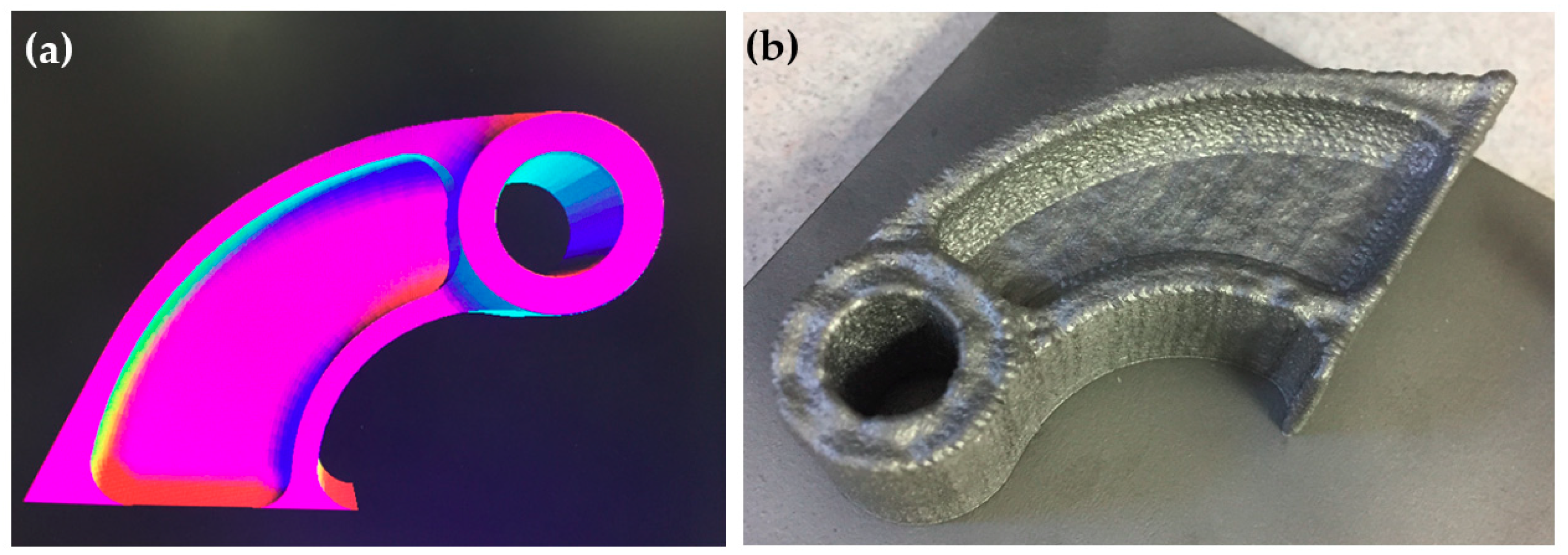
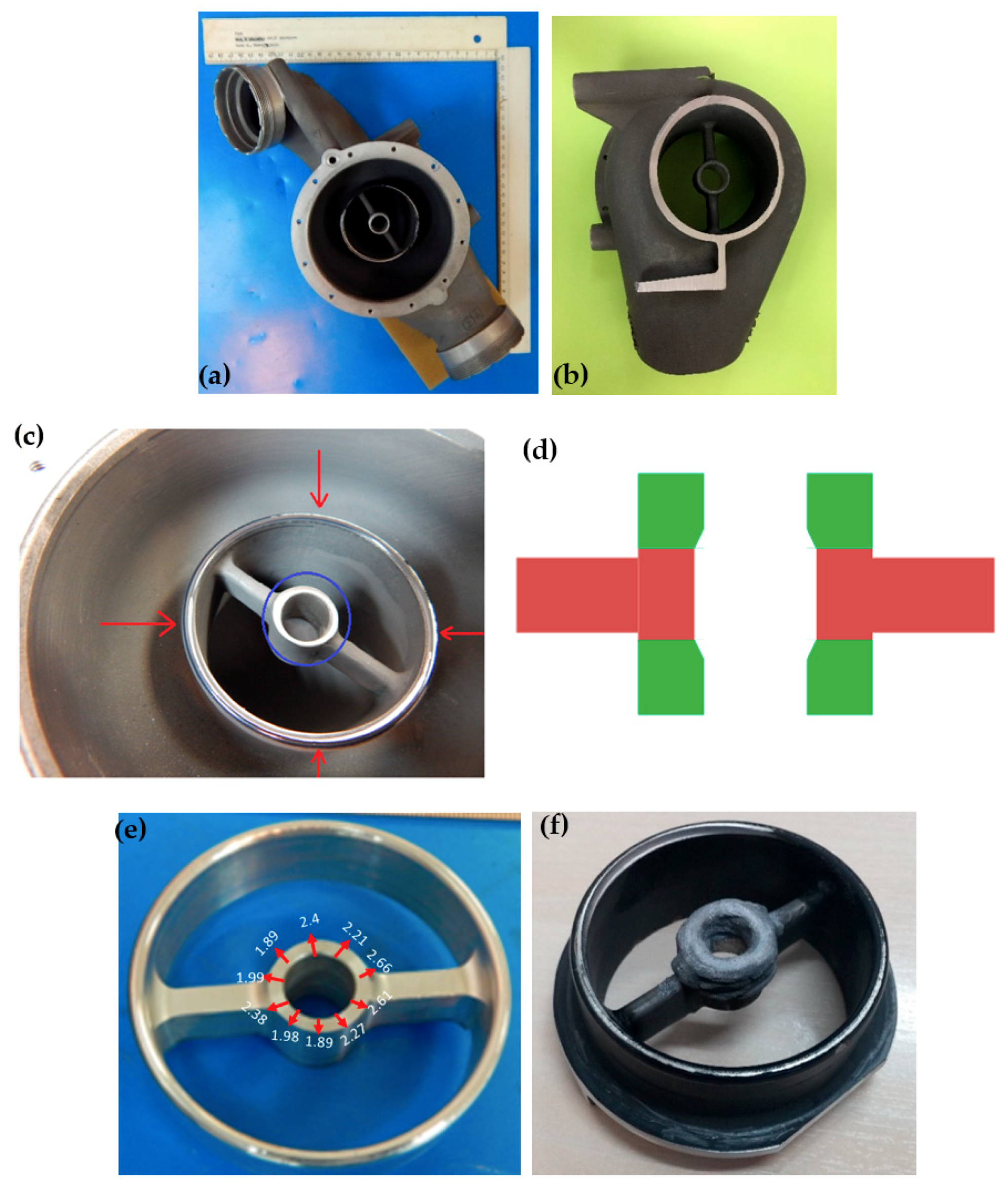


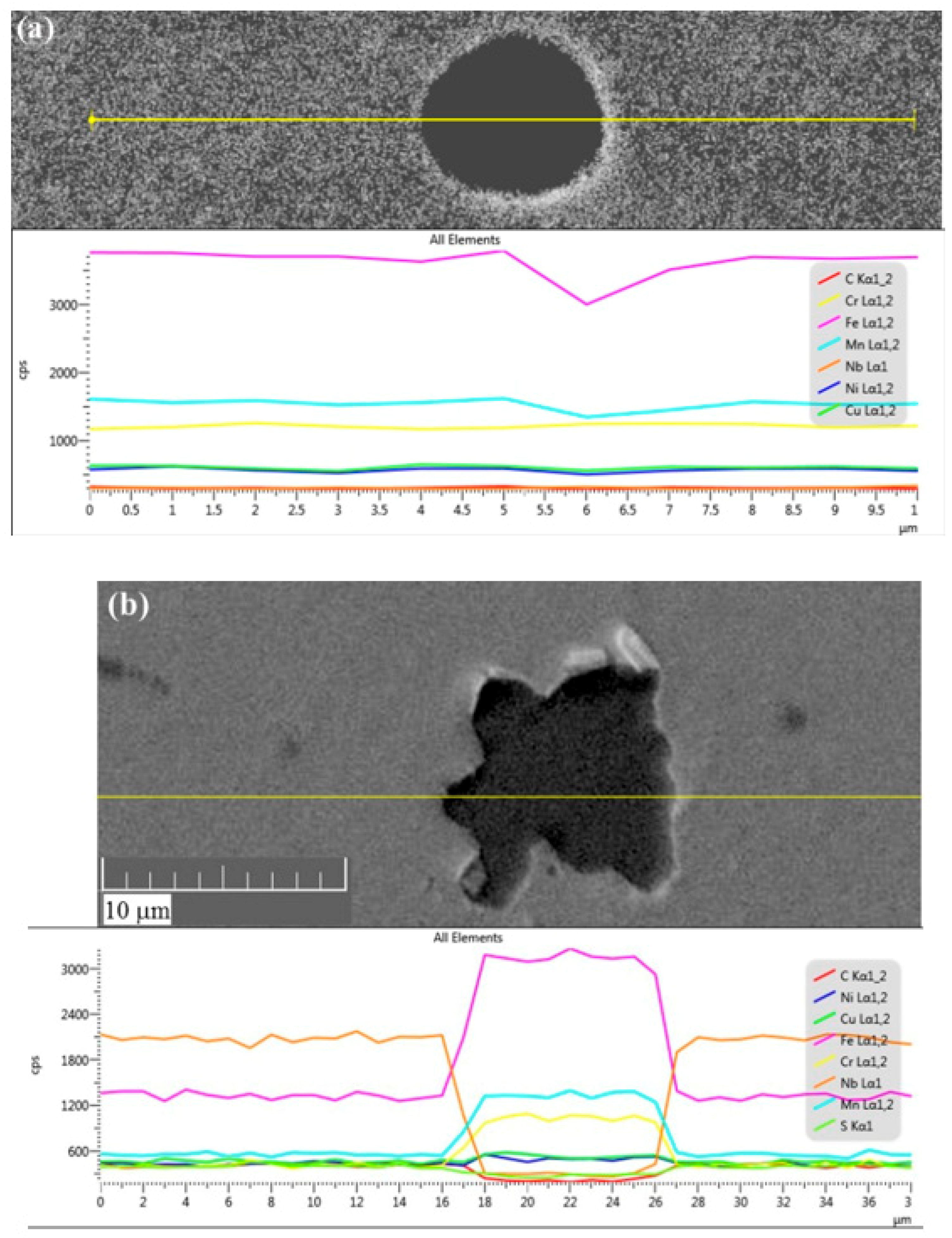
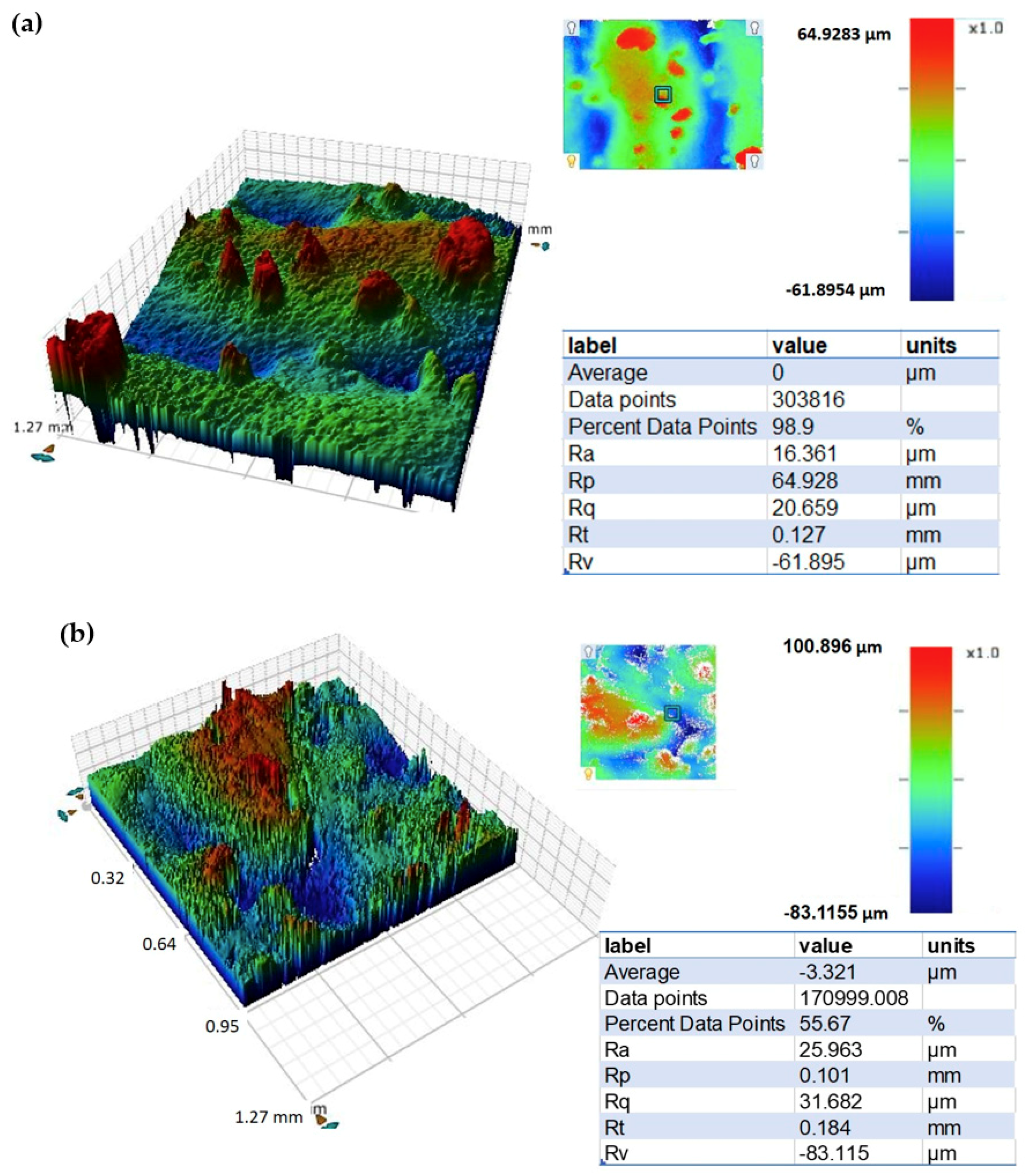
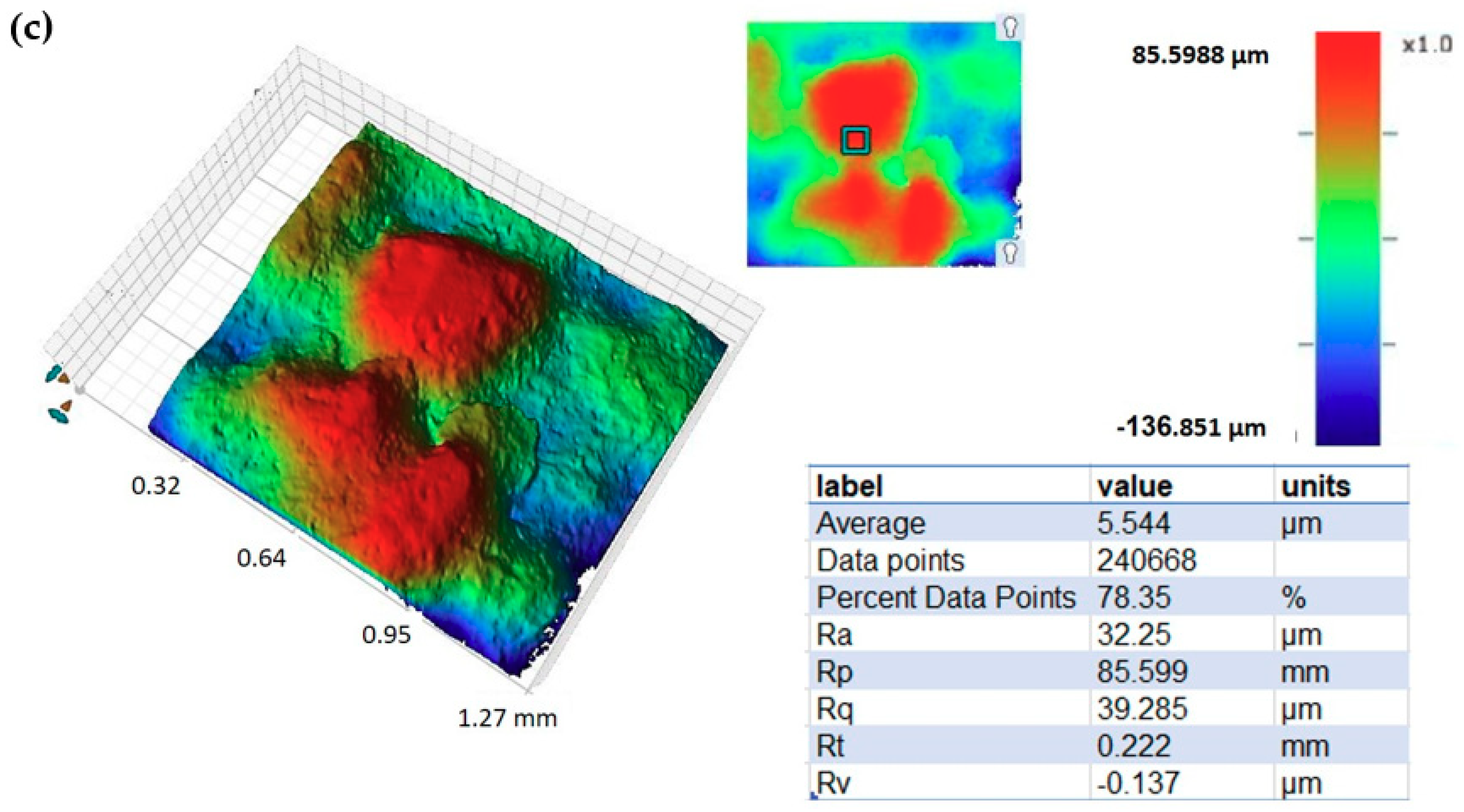
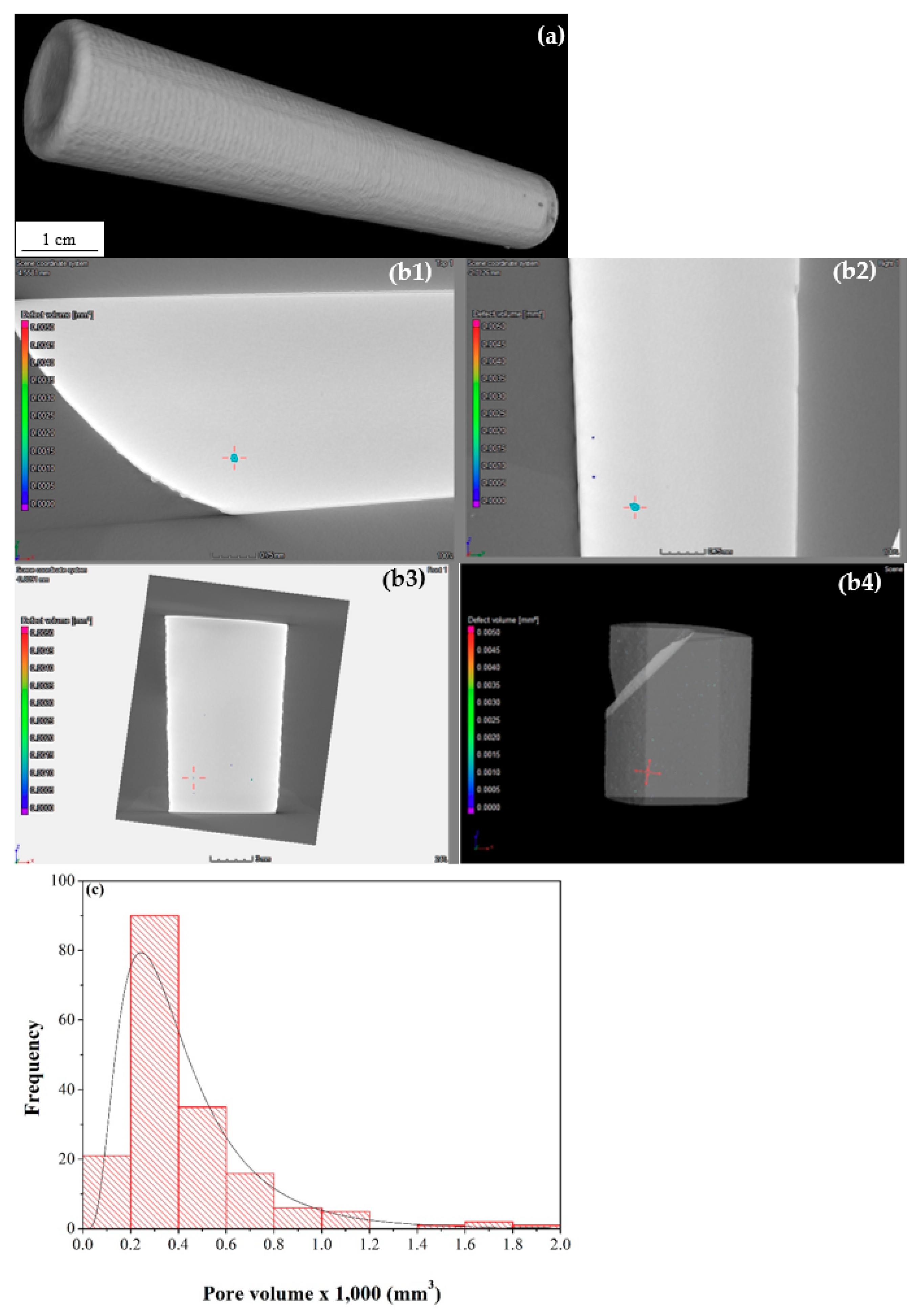

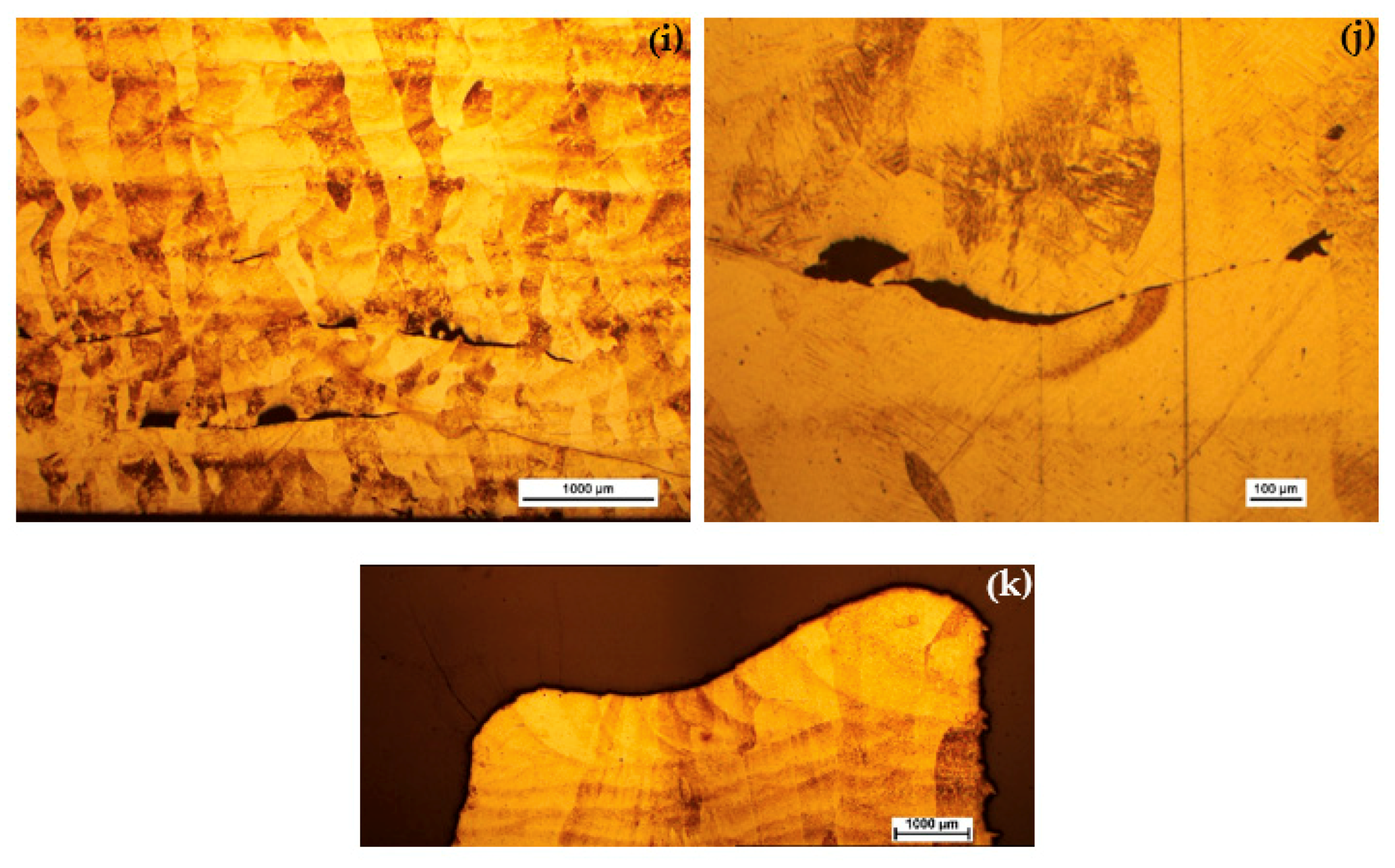

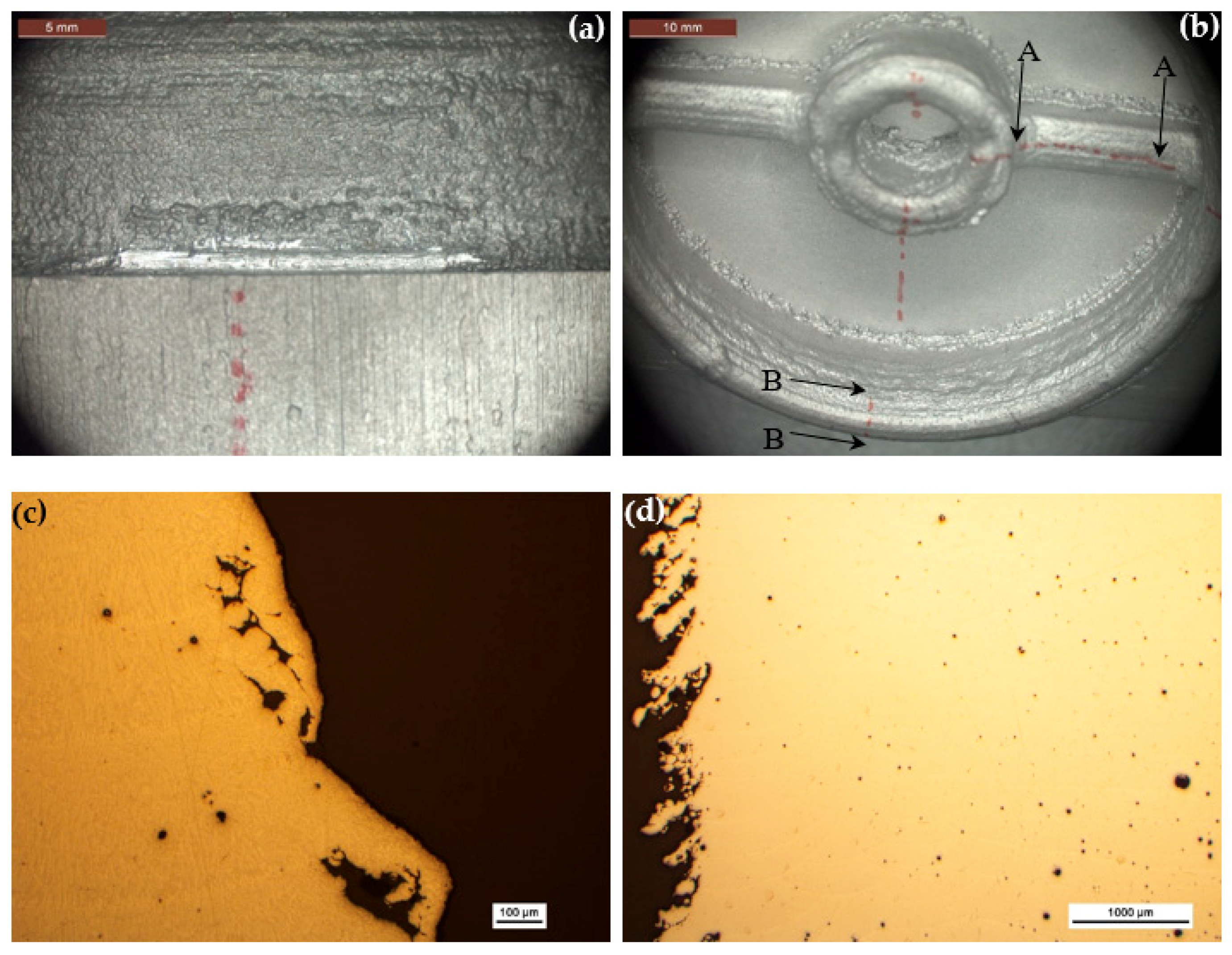



| Item | Deposited Powder | Laser Power (W) | Powder Feed Rate (g/min) | Travel Speed (cm/min) | Layer Thickness (µm) |
|---|---|---|---|---|---|
| Rod | 17-4 PH steel | 380 | 26.16 | 101.6 | 381 |
| Fitting | Ti-6Al-4V | 450 | 3.78 | 63.5 | 381 |
| Housing repair | Al 4047 | 1000 | 9.84 | 76.2 | 254 |
| Item | PH Stainless Steel Rod | SST Standard [44] | Ti-6Al-4V Fitting | Ti-6Al-4V Standard [46] | Al 4047 Housing | Al 4047 Standard [47] |
|---|---|---|---|---|---|---|
| Fe | 73.643 | Bal. | 0.395 | max 0.30 (±0.10) | 0.172 | max 0.80 |
| Cr | 15.760 | 15.00–17.5 | 0.045 | – | 0.002 | – |
| Ni | 4.302 | 3.00–5.00 | 0.024 | – | 0.007 | – |
| Cu | 3.992 | 3.00–5.00 | – | – | 0.003 | max 0.30 |
| Si | 0.949 | max 1.00 | 0.019 | – | 11.23 | 11.0–13.0 |
| Mn | 0.797 | max 1.00 | – | – | 0.001 | max 0.15 |
| Mo | 0.098 | max 0.50 | 0.07 | – | – | – |
| C | 0.034 | max 0.070 | 0.009 | max 0.08 | – | – |
| O | – | – | N/A | max 0.20 | N/A | – |
| N | – | – | N/A | max 0.05 | N/A | – |
| H | – | – | N/A | max 0.015 | N/A | – |
| Nb | 0.233 | 5×C–0.45 | 0.05 | – | – | – |
| P | 0.015 | max 0.040 | – | – | 0.005 | – |
| S | 0.014 | max 0.030 | – | – | – | – |
| Al | 0.018 | 0 (+0.01) [48] | 6.28 | 5.50–6.75 | 88.43 | Bal. |
| V | 0.037 | 0 (+0.03) [48] | 3.74 | 3.50–4.50 | 0.011 | – |
| Y | – | – | – | max 0.005 | – | – |
| Ti | – | – | 89.37 | Bal. | 0.009 | – |
| Mg | – | – | – | – | 0.005 | max 0.10 |
| Zn | – | – | – | – | 0.022 | max 0.20 |
| Be | – | – | – | – | – | max 0.0008 |
| Other elements | 0.108 | – | 0.208 | max 0.40 total, max 0.10 each | 0.127 | max 0.15 total, max 0.05 each |
| Material | Roughness Ra,real (μm) § | Roughness Ra (μm) ‡ | Density (g/cm3) | VHN * |
|---|---|---|---|---|
| 17-4 PH steel | 15.2 ± 8.7 | 16.00 ± 1.26 | 7.816 ± 0.240 | 400.1 ± 46.6 |
| Ti-6Al-4V | 18.7 ± 12.6 | 26.21 ± 4.00 | 4.425 ± 0.020 | 382.3 ± 11.1 |
| Al 4047 | 22.9 ± 12.1 | 27.71 ± 8.95 | 2.649 ± 0.110 | 89.5 ± 9.9 |
© 2020 by the authors. Licensee MDPI, Basel, Switzerland. This article is an open access article distributed under the terms and conditions of the Creative Commons Attribution (CC BY) license (http://creativecommons.org/licenses/by/4.0/).
Share and Cite
Eliaz, N.; Foucks, N.; Geva, D.; Oren, S.; Shriki, N.; Vaknin, D.; Fishman, D.; Levi, O. Comparative Quality Control of Titanium Alloy Ti–6Al–4V, 17–4 PH Stainless Steel, and Aluminum Alloy 4047 Either Manufactured or Repaired by Laser Engineered Net Shaping (LENS). Materials 2020, 13, 4171. https://doi.org/10.3390/ma13184171
Eliaz N, Foucks N, Geva D, Oren S, Shriki N, Vaknin D, Fishman D, Levi O. Comparative Quality Control of Titanium Alloy Ti–6Al–4V, 17–4 PH Stainless Steel, and Aluminum Alloy 4047 Either Manufactured or Repaired by Laser Engineered Net Shaping (LENS). Materials. 2020; 13(18):4171. https://doi.org/10.3390/ma13184171
Chicago/Turabian StyleEliaz, Noam, Nitzan Foucks, Dolev Geva, Shai Oren, Noy Shriki, Danielle Vaknin, Dimitry Fishman, and Ofer Levi. 2020. "Comparative Quality Control of Titanium Alloy Ti–6Al–4V, 17–4 PH Stainless Steel, and Aluminum Alloy 4047 Either Manufactured or Repaired by Laser Engineered Net Shaping (LENS)" Materials 13, no. 18: 4171. https://doi.org/10.3390/ma13184171
APA StyleEliaz, N., Foucks, N., Geva, D., Oren, S., Shriki, N., Vaknin, D., Fishman, D., & Levi, O. (2020). Comparative Quality Control of Titanium Alloy Ti–6Al–4V, 17–4 PH Stainless Steel, and Aluminum Alloy 4047 Either Manufactured or Repaired by Laser Engineered Net Shaping (LENS). Materials, 13(18), 4171. https://doi.org/10.3390/ma13184171






